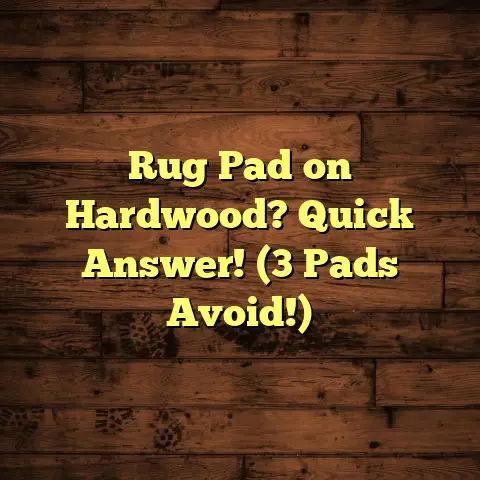Can You Use Cement Board For Subfloor? (Explained)
I remember the first time I walked into a home renovation project where the existing flooring was a mess.
The old tiles were cracked, and the wooden subfloor beneath was rotting away.
As a flooring contractor with years of experience, I knew that a solid foundation was crucial for any flooring type to perform well.
That’s when I first considered using cement board as a subfloor option.
Understanding Cement Board for Subflooring
Cement board has become quite popular in the flooring industry, especially in areas prone to moisture, like bathrooms and kitchens.
But can you really use it as a subfloor?
My experience has shown that while cement board offers unique benefits, it also comes with its share of challenges.
What is Cement Board?
Cement board is primarily made from Portland cement and reinforced with fiberglass mesh.
This composition makes it durable and resistant to moisture.
I’ve found that when I use it in wet areas, it helps prevent water damage and mold growth, which are common problems in traditional subfloors.
Personal Insight:
A few months back, I worked on a bathroom remodel where the homeowner wanted to ensure longevity and durability.
We used cement board as the underlayment for ceramic tiles.
The peace of mind knowing that moisture wouldn’t compromise the floor was worth every penny.
Types of Cement Board
There are several types of cement boards available in the market, each designed for specific applications:
- Cement Backer Board:
This is the most commonly used type for tile installations.
It provides a solid surface for tiles and is resistant to moisture. - Fiber Cement Board:
This type contains cellulose fibers along with cement, making it lighter than traditional cement backer boards.
It’s often used in exterior applications. - Water-Resistant Cement Board:
This variation is specifically designed for areas exposed to high moisture levels, such as showers and wet rooms.
It incorporates additional protective features.
Experience with Different Types:
I’ve worked with all three types over the years.
For instance, when I used fiber cement board on an outdoor patio project, it held up beautifully against the elements.
However, for indoor bathrooms, the standard cement backer board has consistently proven to be the best choice.
Installation Process
Installing cement board isn’t as straightforward as it might seem.
Here’s how I typically go about it:
- Preparation:
Ensure that the existing subfloor is clean and level.
Any imperfections can lead to problems later on.
I always check for squeaks or movement in the floor before proceeding.
If I find any issues, I make necessary repairs before moving forward. - Cutting the Board:
Using a utility knife, I score the cement board and then snap it along the cut line.
It can be heavy, so I recommend having a second person help if you’re working with larger sheets. - Fastening:
I use galvanized or stainless-steel screws to secure the cement board to the subfloor.
It’s crucial to space these screws about 8 inches apart to prevent movement. - Sealing Gaps:
After fastening, I fill the seams with thin-set mortar and tape them with fiberglass mesh tape.
This step helps create a seamless surface. - Leveling:
Once installed, I check for any uneven areas using a level tool.
If necessary, I can use self-leveling compound to ensure a flat surface before laying down any final flooring material.
Challenge Faced:
In one project, I underestimated how much time it would take to properly install cement board in a large kitchen area.
The cutting and fastening took far longer than anticipated.
So, if you’re considering this, make sure to allocate enough time in your schedule.
Cost Considerations
One of the biggest questions homeowners ask is about cost.
When I estimate flooring projects, I rely heavily on FloorTally to provide accurate cost assessments.
The platform pulls local material and labor rates, which helps me present realistic budgets to my clients.
For a typical installation of cement board as a subfloor, you might be looking at around $1.50 to $3.00 per square foot for the material alone.
Adding in the installation costs, which can vary based on location and complexity, might bring you up to $5.00 or more per square foot in total.
Tip:
Always account for additional materials like screws, adhesive, and tape when budgeting.
Pros and Cons
Pros:
- Durability: Cement board is incredibly durable compared to plywood or OSB.
- Moisture Resistance: Perfect for wet areas where other materials might fail.
- Fire Resistance: Offers better fire resistance compared to traditional wood-based products.
Cons:
- Weight: It’s heavier than most other subfloor materials, making it more challenging to handle.
- Cost: While durable, it can be more expensive upfront.
- Installation Time: Requires more time and effort compared to simpler alternatives.
Comparing Options
Over the years, I’ve experimented with various subfloor materials, including plywood and OSB.
Here’s how they stack up against cement board:
- Plywood: Lighter and easier to install but not as moisture-resistant.
In areas prone to water exposure, I’ve often had clients dealing with warping or mold issues. - OSB: Similar performance to plywood but tends to swell when exposed to moisture.
I’ve had to replace OSB subfloors more frequently than cement board ones in wet environments.
In my experience, while plywood and OSB have their merits, cement board is often the best choice for areas where moisture is a concern.
Practical Tips for Maintenance
Keeping your cement board subfloor in good shape requires minimal effort:
- Regular Inspections: Check for any signs of moisture or damage, especially after heavy rains or leaks.
- Sealants: If you’re using it in wet areas, consider applying a sealant on top once your flooring is installed for added protection.
- Ventilation: Ensure proper ventilation in spaces like bathrooms to keep humidity levels down and prevent potential issues.
Real-Life Applications
In my career as a flooring contractor, I’ve encountered numerous situations where choosing cement board made all the difference:
- Kitchen Remodel:
During a recent kitchen remodel, we opted for cement board beneath tile flooring due to concerns about spills and moisture from cooking activities.
The homeowner was thrilled with how well the floor held up over time. - Basement Flooring:
In another instance, a client wanted to convert their basement into a living space.
We used cement board beneath luxury vinyl planks because of its resistance to moisture from ground seepage.
The result was an attractive and functional living area that remained dry.
Common Misconceptions
There are many misconceptions about using cement board that I’ve encountered over the years:
- Too Heavy: Some think it’s too heavy for residential applications; however, while it is heavier than plywood or OSB, its benefits often outweigh this drawback.
- Difficult Installation: Many people believe installing cement board is overly complicated.
With the right tools and preparation, it can be just as straightforward as other materials. - Only for Tile Floors: While it’s commonly used under tile floors, cement board can also serve as an excellent base for other types of flooring like vinyl or laminate.
Troubleshooting Common Issues
Even with careful installation, issues can arise with cement board subfloors:
- Cracking: This could happen if the boards aren’t properly secured or if there’s movement in the underlying structure.
- Moisture Issues: While cement board is water-resistant, it’s not waterproof.
If there are leaks above or around it that aren’t addressed, moisture can still infiltrate. - Uneven Surfaces: If not installed properly or if the underlying floor isn’t level, you could end up with an uneven surface that affects your final flooring choice.
Advice on Troubleshooting:
Always double-check your work during installation—spend extra time making sure everything is level and secure before proceeding with your final flooring layer.
Long-Term Benefits
Investing in a quality subfloor like cement board pays off in the long run:
- Longevity of Flooring Material: With a solid foundation, your final flooring material will perform better and last longer.
- Reduced Maintenance Costs: By preventing water damage and mold growth, you’ll save money on repairs down the line.
- Increased Home Value: A well-installed floor with quality materials can enhance your home’s value when it comes time to sell.
Alternative Subfloor Solutions
While cement board is an excellent choice for many situations, there are alternatives worth considering:
- Plywood or OSB: These are often less expensive but may not hold up as well in moist environments.
- Concrete Slabs: In some cases, using concrete as a subfloor can be beneficial; however, they often require additional insulation measures.
- Foam Underlayment: For certain flooring types like laminate or engineered hardwoods, foam underlayment can provide soundproofing and cushioning but lacks durability compared to cement board.
Future Trends in Flooring Substrates
As technology evolves within the flooring industry, new materials and methods continue to emerge:
- Sustainable Materials: Increasingly, eco-friendly options are becoming available for those looking to reduce their environmental impact.
- Advanced Composites: These materials aim to combine the benefits of existing products while addressing their weaknesses—moisture resistance without added weight.
My Thoughts on Future Trends:
As trends continue towards sustainability and innovation, I’m excited about the potential advancements in flooring substrates that could further enhance durability and ease of installation.
Conclusion
Choosing cement board as a subfloor material can be an excellent decision for moisture-prone areas in your home.
With its durability and resistance to water damage, it provides a solid foundation for various flooring types.
However, it’s essential to weigh the pros and cons based on your specific needs and budget.
While it may require a higher initial investment and more time for installation, the long-term benefits often outweigh these drawbacks.
If you’re considering this option for your flooring project, think about your environment and what you’re aiming for with your finished floor.
Just remember—like any material, cement board has its strengths and weaknesses, but with careful planning and execution, it can deliver impressive results that last for years.
Ultimately, every project is unique; what works best will depend on individual circumstances and preferences.
Whether you choose cement board or another option entirely, thorough preparation and attention to detail will help ensure successful outcomes for your flooring projects.





